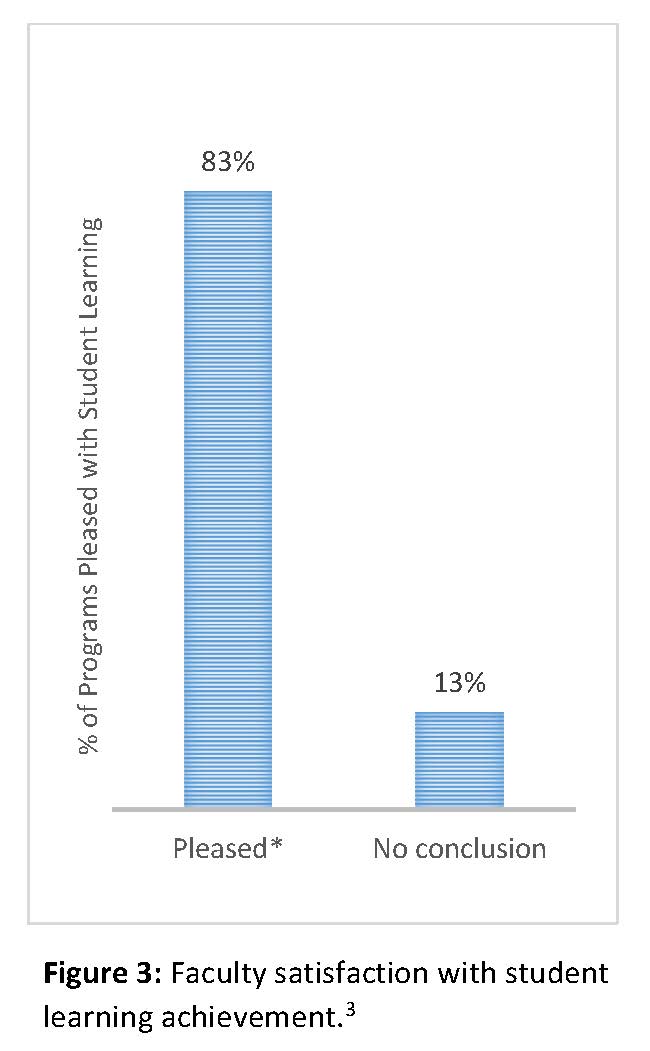Overview
Annually, the faculty of each undergraduate major, standalone minor, and required General Education courses examine student achievement of at least one intended learning outcome for their degree program. Through this work, the faculty confirm students are developing the skills and knowledge expected of a graduate in their discipline.
For the academic year 2014-15, this page provides a summary of
- students’ self-perceptions of their knowledge and abilities,
- the faculty’s conclusions about student learning achievement in undergraduate majors, standalone minors,and required General Education courses,
- actions identified to improve student learning, and
- budget implications for proposed improvements to student learning
Links to the intended learning outcomes for each degree are available here. An overview of the annual assessment process is available here. Undergraduate retention and graduation rates are available here.
Please address questions to Laura Martin.
Student Perceptions of their Learning

Across all majors, a large majority of seniors1 reported being highly or moderately proficient at the skills and knowledge expected of a graduate from their major or minor (Figure 1). These results are nearly identical for to those for 2013-14.
These seniors also perceived growth in their knowledge and abilities while at UCM. Fewer than three out of 10 reporting seniors (28%) recalled having high or moderate levels of proficiency in skills and knowledge particular to their major or minor at matriculation (Figure 1).
Seniors also reported substantial growth2 in a core set of skills and knowledge expected of a bachelor’s degree recipient (Figure 2). Global ratings, like this, likely reflect the entire educational experience, including the major, General Education, and extra-curricular activities.

Faculty Perceptions of Student Learning

The vast majority of undergraduate programs (83%) were pleased with the skills and knowledge demonstrated by students in relation to the intended learning outcomes (Figure 3).3 This indicates that, on the whole, students were achieving program benchmarks or were otherwise meeting or exceeding the faculty's performance expectations.
These results are similar to those for 2013-14. However, in 2014-15, a slightly smaller fraction of programs (4%) reported being displeased with student learning and a slightly larger fraction drew no conclusions about student learning.
In drawing these conclusions, faculty examined diverse types of student work. These included research papers, senior theses, essays, oral presentations, final exam questions, homework assignments, standardized national exams, concept inventories, and capstone design projects.
Faculty Actions to Improve Student Learning
While the vast majority of programs (83%) were pleased with student performance, nearly 75% responded to assessment results by identifying actions to support continued improvement in student learning. Again, these results are very similar to those for 2013-14.
Example actions included increasing the frequency with which students practice important intellectual skills throughout the curriculum, increasing the frequency of course offerings, communicating learning expectations more clearly to students, offering supplemental instruction, and re-examining curriculum in light of learning results.
Twenty-five percent of programs chose to not change program curriculum or instructional strategies, reflecting strong satisfaction with student performance or concern about the reliability of learning results due to small sample sizes.
Budget Implications of Actions to Improve Student Learning
Of those programs identifying actions to improve student learning, 45% requested resources to support proposed changes. About 70% of the requests referenced existing sources of support, thereby reinforcing the importance of these resources to faculty work and student success.
Requests for new resources included support to implement a capstone, to diversify course offerings in the major, to increase the frequency with which particular courses are taught, and to increase capacity for writing intensive courses.
As in 2013-14, nearly a quarter of programs explicitly cited continued support of professional teaching, learning, and assessment staff as important to future work.
Faculty Commitment to Examing Student Learning in Majors, Minors, and General Education
UC Merced faculty demonstrated commitment to systematically examining the effectiveness of their degree programs in cultivating intended student learning. In 2014-15,
- 80% of majors,
- 100% of required General Education courses,
- and 100% of standalone minors
submitted a report describing their efforts to assess student achievement of intended learning outcomes.
Student Achievement: Graduation and Retention Rates
For information on undergraduate retention and graduation rates, visit http://irds.ucmerced.edu/student.htm
1Data from the 2015 Graduating Senior Survey. Values are averages across all students. For each learning outcome for their major, graduating seniors rated themselves as highly proficient, moderately proficient, barely proficient, or not proficient for two time points: the time they took the survey (Today) and, retrospectively, when they started at UCM (When started at UCM).
2 Data from the Spring 2014 University of California Undergraduate Experience Survey (UCUES). For each skill responding seniors rated their abilities as excellent, very good, good, fair or poor for two time points: as seniors and when they started UC Merced as freshmen. Data from the 2016 UCUES administration will be provided when available.
3 As represented in the annual learning outcome report submitted by each program, including major, standalone minor, and required General Education courses (n=23). For each report, faculty conclusions regarding student learning outcomes were aligned to a Likert scale of very pleased, pleased, somewhat pleased, somewhat displeased, displeased, very displeased. In Figure 3 specifically, “Pleased” includes scores of very pleased, pleased, and somewhat pleased. Slightly more than half of programs (52%) were pleased or very pleased with student performance.

